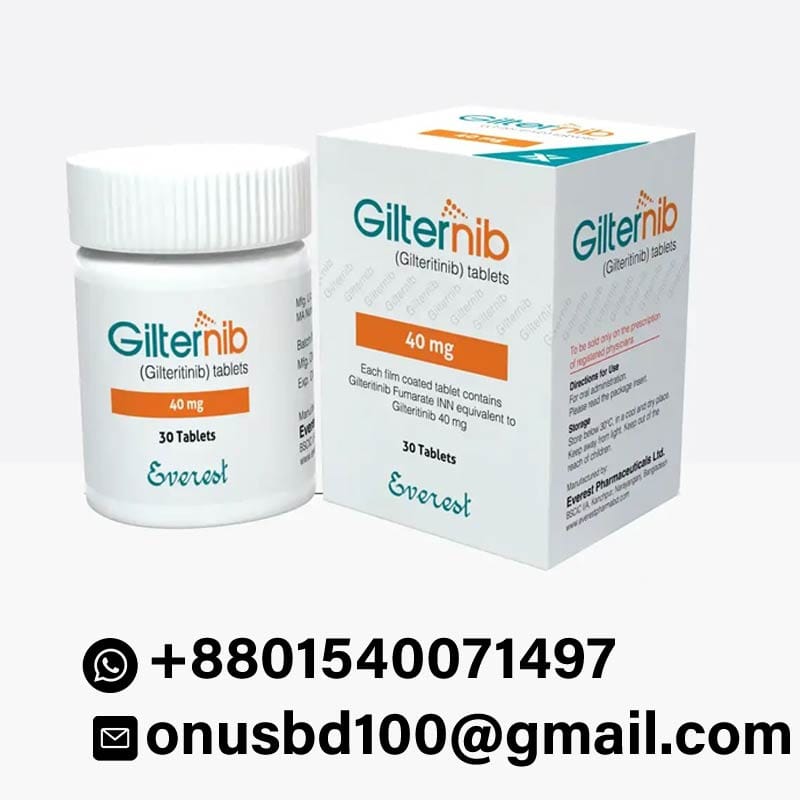Address
304 North Cardinal
St. Dorchester Center, MA 02124
Work Hours
Monday to Friday: 7AM - 7PM
Weekend: 10AM - 5PM
Address
304 North Cardinal
St. Dorchester Center, MA 02124
Work Hours
Monday to Friday: 7AM - 7PM
Weekend: 10AM - 5PM

Original price was: $280.00.$265.00Current price is: $265.00.
Medication Name: Gilternib
Strength: 40 mg
Volume: 30 Tablets
Manufacturer: Everest Pharmaceuticals
Generic Name: Giltertinib Fumarate
WeChat QR code:

WhatsApp: +8801540071497
Gilternib 40 mg is a targeted treatment developed for patients identified with FLT3-mutated Acute Myeloid Leukemia (AML). Unlike traditional chemotherapy which kills both healthy and malignant cells, FLT3 inhibitors such as Gilternib offer a more personalized treatment approach by targeting the specific genetic mutations that drive cancer growth.
FLT3 mutations primarily FLT3-ITD and FLT3-TKD are identified in an essential part of AML cases. Gilternib works by impeding the activity of this defective receptor, usefully stopping the fast and unusual enhancement of leukemic cells. This procedure makes it an important option for patients with relapsed or refractory AML, where previous treatment attempts have failed.
Genomic medicine is changing how we fight blood cancers. Gilternib 40 mg tablets are prescribed based on genetic testing results, which helps oncologists adapt treatments according to the distinctive molecular profile of each patient. This technique not only magnifies treatment benefits but also reduces needless disclosure to toxic agents.
The ability of Gilternib to individually inhibit FLT3 provides consequential clinical advantages including long-term remedy, improved event-free survival, and better overall survival rates. Gilternib has been acknowledged by several international guidelines, including NCCN and EMA as a major advancement in second-line AML therapy.
While Gilternib is an effective therapy, continual observation is crucial during its use. Patients regularly need to check blood counts, liver function tests, and ECGs to detect any adverse direction. It is essential for physicians to evaluate cardiotoxicity risk, as QT interim extension is a known risk.
As well, bone marrow tests may be suggested frequently to evaluate treatment response. Early recognition of hematologic improvement or disease progression helps guide timely clinical decisions, whether it’s dose modification or converting into other therapies.
The maximum plasma concentration is ordinarily achieved within 2 to 6 hours and it is well-absorbed when given by mouth. In addition to this, the drug has a half-life of almost 113 hours hence once daily dosing.
Use Gilternib cautiously with potent CYP3A4 inhibitors or inducers as they may substantially modify Gilternib plasma concentration since the liver enzyme CYP3A4 has a high contribution to drug metabolism. Making an evaluation of drug interaction a very important aspect in managing the patient.
Gilternib 40 mg is mostly employed as monotherapy in patients with relapsed or refractory AML but ongoing investigations are determining its inclusion in combination regimens. It has been proven that combining FLT3 inhibitors with hypomethylating agents or low-dose cytarabine yields optimistic results for older adults and unfit patients regarding extended response rates.
Future directions in AML will include adding targeted therapies such as Gilternib to first-line regimens in newly diagnosed patients with mutations particularly FLT3.
The therapeutic action of Gilternib depends on its ability to hold back the FLT3 tyrosine kinase receptor, a primary cause in many hostile AML forms. By tying up the receptor’s ATP-binding site, Gilternib impedes the phosphorylation process, effectively breaking downstream signaling routes involved in cell proliferation and survival.
In addition to FLT3 inhibition, Gilternib has shown activity against AXL, another tyrosine kinase compiled in drug resistance. This dual inhibition profile may explain why Gilternib 40 mg remains effective in some patients who have failed earlier FLT3 inhibitors.
One of the biggest challenges in AML treatment is hostility to chemotherapy. Gilternib offers a strong solution by picking out molecular escape mechanisms. For instance, FLT3-ITD mutation confers resistance to usual agents, but Gilternib’s notably toward this mutation raised treatment sensitivity.
This will allow the oral version of Gilternib 40 mg for home-based therapy reducing hospital visits and improving the quality of life for patients with advanced disease. To keep these benefits long-term monitoring will be essential.
Clinical studies indicate that patients treated with Gilternib meet longer extended revocation and extended leukemia-free survival. To perpetuate these gains, long-term monitoring is needed.
After treatment, the action plan may comprise maintenance therapy in addition to regular imaging and molecular monitoring for any minimal residual disease (MRD ). This ensures that relapse is detected at an early stage and can subsequently be acted upon, thereby contributing to durable disease control.
Recommended Dose:
Dose Modifications:
Missed Dose:
Like other kinase inhibitors, Gilternib also may cause side effects with very intensity. Precautions and consistent patient management can improve outcomes.
Onus Pharma is committed to delivering high-quality generics like Gilternib 40 mg to patients worldwide at moderate prices. By making advanced targeted therapies accessible, we help link the gap between innovation and affordability. With growing demand for FLT3 inhibitors in emerging markets, our distribution model ensures immaculate supply and patient support.
We also partner with global oncology networks to promote awareness, provide treatment guidance, and support clinical decision-making through updated resources.
Reviews
There are no reviews yet.